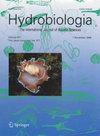墨西哥太平洋耶拉帕礁岩生态系统的营养网络结构和动力学模拟
IF 0.3
4区 生物学
Q4 MARINE & FRESHWATER BIOLOGY
引用次数: 0
摘要
背景。生态网络分析已被用于界定海洋生态系统的结构、健康和动态等方面。目标。评价耶拉帕浅层礁岩生态系统的结构、组织和成熟度。此外,我们还通过模拟干扰确定了受影响最大的功能群和那些在生态系统中产生较低弹性的功能群。方法。利用Ecosim软件构建了生态系统质量平衡营养模型Ecopath,并运用优势理论对生态系统特性进行了评价。使用混合营养影响矩阵来评估对网络的直接和间接营养影响。在短期和长期两种死亡率情景(增加25%和50%)下,采用Ecosim动力学模拟确定了对干扰更敏感的官能团。最后,系统恢复时间被用作弹性的度量。结果。叶拉帕岩礁生态系统表现出成熟、有组织和发展的生态系统特征,但对干扰的抵抗力较弱。几种鱼类、浮游动物和浮游植物在营养网络中产生了最显著的影响。此外,浮游植物、绿藻和其他底栖无脊椎动物群对其他模式组分的影响更大。结论。叶拉帕岩礁的功能群若发生变化,将失去恢复力。海鳗、其他底栖无脊椎动物、鲷鱼和浮游植物受到了干扰。本文章由计算机程序翻译,如有差异,请以英文原文为准。
Trophic network structure and dynamics simulations of the rocky–reef ecosystem of Yelapa, Mexican Pacific
Background. Ecological Network Analysis has been used for defining aspects concerning the structure, health, and dynamics of marine ecosystems. Objectives. Evaluate the ecosystem’s structure, organization, and matu-rity in the shallow rocky reef ecosystem in Yelapa. Also, we determine the most affected functional groups by disturbances simulated and those which generate less resilience in the ecosystem. Methods. A mass-balan-ce trophic model Ecopath with Ecosim, was constructed, and Ascendency›s theory was used to evaluate the ecosystem properties. A Mixed Trophic Impacts matrix was used to assess direct and indirect trophic effects on the network. The functional groups more sensitive to disturbances were determined using Ecosim dynamics simulations in the short and long term with two mortality scenarios (an increase of 25 % and 50 %). Finally, the System Recovery Time was used as a measure of resilience. Results. The Yelapa rocky-reef ecosystem ex-hibits the feature of a mature, organized, and developing ecosystem but is less resistant to disturbances. Several fish groups, zooplankton, and phytoplankton produced the most remarkable effects in the trophic network. In addition, the phytoplankton, chlorophyta, and the group of other benthic invertebrates propagated more effects on other model components. Conclusions. Yelapa rocky reef would lose resilience if the functional groups eels & morays, other benthic invertebrates, snappers, and phytoplankton were disturbed.
求助全文
通过发布文献求助,成功后即可免费获取论文全文。
去求助
来源期刊

Hidrobiologica
生物-海洋与淡水生物学
CiteScore
0.40
自引率
0.00%
发文量
8
审稿时长
>12 weeks
期刊介绍:
HIDROBIOLÓGICA es una publicación cuatrimestral que difunde trabajos originales e inéditos de investigación o revisión, sobre temas relacionados con los organismos y la hidrología de los ambientes acuáticos, dulces y marinos y va dirigida a investigadores de todo el mundo, interesados en las diversas disciplinas que incluye la Hidrobiología , así como a alumnos de posgrados y licenciaturas relacionados con la biología, ecología, taxonomía, filogenia y evolución de organismos acuáticos, e hidrología y oceanografía de ambientes s dulceacuícolas y marinos.
 求助内容:
求助内容: 应助结果提醒方式:
应助结果提醒方式:


